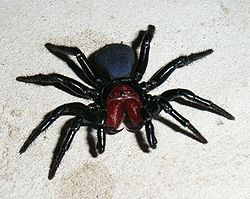| Actinopodidae | |
|---|---|
 | |
| M. occatoria , male | |
| Scientific classification | |
| Kingdom: | Animalia |
| Phylum: | Arthropoda |
| Subphylum: | Chelicerata |
| Class: | Arachnida |
| Order: | Araneae |
| Infraorder: | Mygalomorphae |
| Clade: | Avicularioidea |
| Family: | Actinopodidae Simon, 1892 |
| Genera | |
3, see text | |
| Diversity | |
| 3 genera, 124 species | |
 | |
| blue: reported countries (WSC) green: observation hotspots (iNaturalist) | |
Actinopodidae is a family of mygalomorph spiders found in mainland Australia and South America usually in open forest. Species are most common in Queensland, Australia. [1] It includes mouse spiders ( Missulena species), whose bites, though rare, are considered medically significant and potentially dangerous. [2]